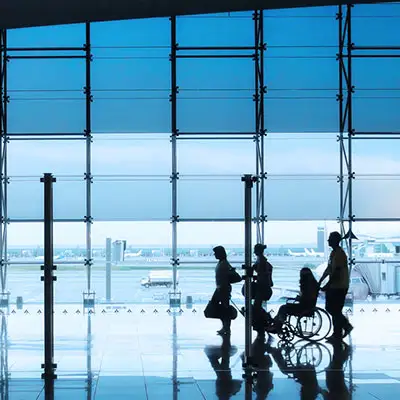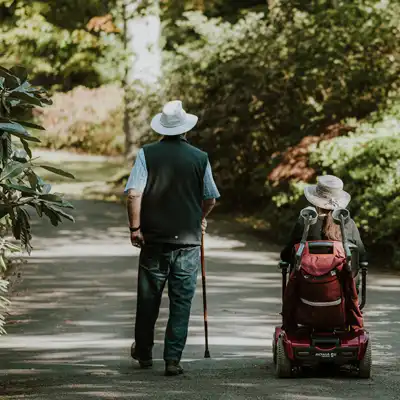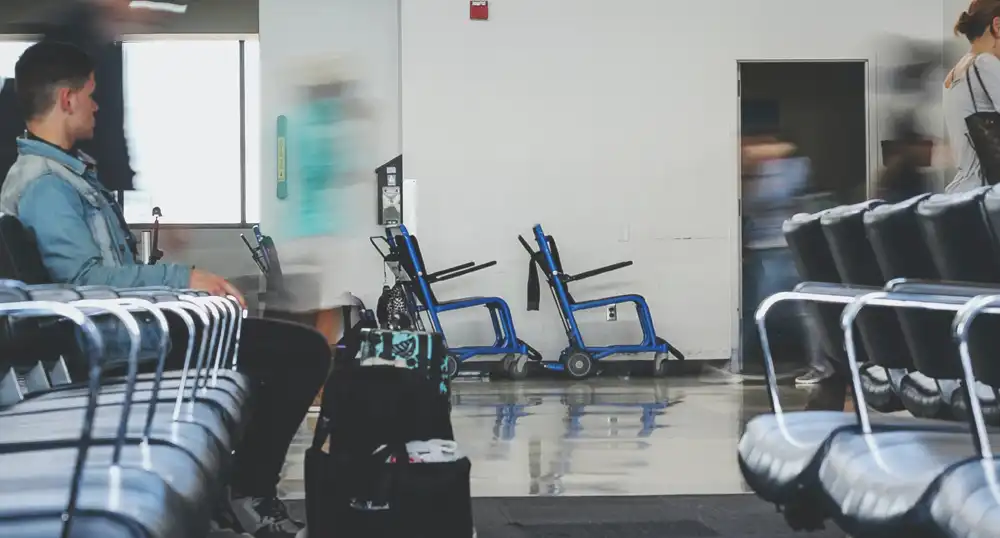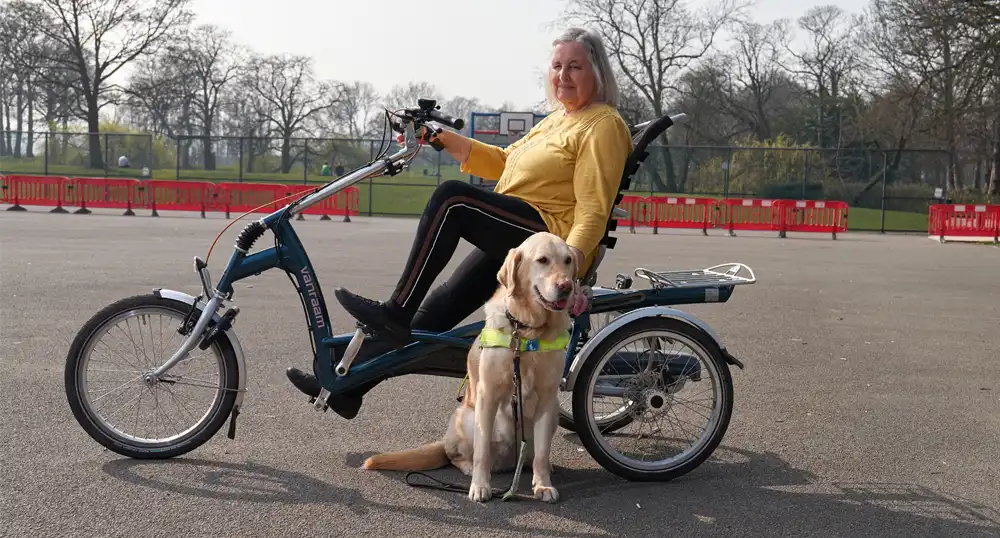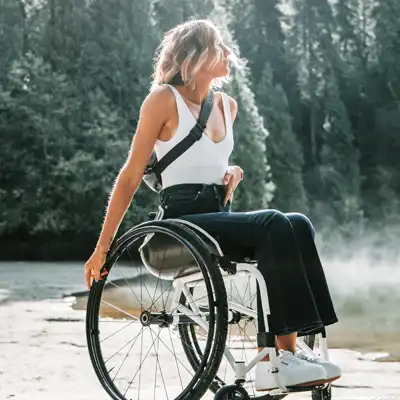Everyone deserves and has the right to travel. As much as that belief is a part of our Seven Corners DNA, we can’t deny that some people face more of an uphill battle than others when it comes to living out their travel dreams.
According to the World Health Organization, about 1.3 billion people worldwide — that’s 1 in 6 — have a significant disability. In the United States alone, the Centers for Disease Control and Prevention reports that more than 1 in 4 people have a disability. As the global population ages, these numbers are only expected to grow.
Of course, individuals with disabilities aren’t content to sit at home all day, and nor should they be. Travel is a key part of experiencing life to the fullest. We’d be the last to deny that it’s a worthy investment of time and resources.
That investment has never been higher, either. In 2015, the Open Doors Organization estimated that Americans with disabilities spent $34.6 billion on travel. By 2019, that had increased to $58.7 billion. Worldwide, Adventure Travel News found that individuals with disabilities spend $95 billion annually on travel.
So what does it mean to be a traveler with a disability? And how can we overcome the challenges that arise when we strike out on the road? While the answers to those questions vary greatly depending on the individual — the types and severity of disabilities, not to mention personal preferences all play a role — it's clear that traveling with a disability is not only possible, but also 100% worth it.
What Are the Benefits of Travel for People with Disabilities?
Travel has the potential to shatter harmful stereotypes, improve communication, and even boost creativity. Although travelers with disabilities may encounter different kinds of obstacles than their non-disabled peers, the benefits of the adventure often outweigh the challenges.
Simultaneously one of the best and worst things about travel is being forced outside of your comfort zone. New customs, languages, or even simply a new daily routine can make anyone feel unsettled.
For individuals with disabilities who perhaps feel greater anxiety about the unknown or who are looking to build confidence amidst struggles, travel is a relatively safe way to take that leap of faith. What’s better than coming home with a boost of self-esteem?
Travel also affords opportunities for greater social engagement. Many individuals with disabilities are involved in online communities, and traveling to meet those peers in person can reduce feelings of isolation and foster valuable friendships.
Children and teens with disabilities can also benefit from time away from home. In an interview with CNN, Jani Nayar of the Society for Accessible Travel & Hospitality highlighted how important it is for children with disabilities, regardless of what that disability might be, “to get out of the house and travel like any other child.”
What Are the Challenges of Traveling with a Disability?
Challenges most often fall into two categories: transportation and lodging. These can deter individuals from traveling at all or, in some cases, force them to pay more for their travel arrangements to secure accommodations that make their trips possible or more comfortable.
1. Airport terminals are complex.
The complexity of airport layouts and the sheer distances they can cover may make it difficult for individuals with physical disabilities. If a mobility or vision impairment makes navigating the terminal an obstacle for you, contact your airline as soon as you book your ticket and request extra assistance.
You can also try technology like the Aira navigation app, which provides visual interpreting services via your smartphone. Using your phone’s camera, an Aira agent visually interprets your surroundings, including reading, describing surroundings, and navigating.
2. Gate changes and flight announcements may be missed.
This is particularly true for those with vision or hearing impairments. Think about the information missed if you can’t see a departure board or hear an announcement regarding a gate change, where to claim luggage, or safety notices.
To combat this, request assistance from the airline and the gate agents, and ask them to notify you of changes. You can also get notifications sent to your phone from most airlines, informing you of a change in gate or flight details.
3. Transportation hubs can be overwhelming for those with sensory issues.
For travelers with sensory challenges, airport terminals and bus or train stations can be extremely loud and busy, causing extreme stress or prohibiting them from traveling. Traveling in the early mornings, late at night, or mid-week, when there are less crowds, can help remove some of the anxiety. Traveling during the offseason may also help if you have schedule flexibility.
Also research the availability of sensory rooms in the terminal. More airlines are creating sensory rooms and quiet spaces to help those on the autism spectrum or with sensory disorders.
It can also be helpful to practice processes, like going through security or boarding a plane. Kansas City International Airport built a simulation experience in its renovated terminal that opened in early 2023. Using a decommissioned commercial jet, actual check-in kiosks, and an imitation jet bridge, passengers can practice every process from check-in to finding your seats and stowing luggage to take-off and landing, all from the ground.
This allows anxious flyers, whether they’re first-time flyers or a traveler with a disability, to become more familiar with the experience and reduce stress arising from uncertainty.
4. Security checkpoints can also be trigger points.
Wheelchairs often set off metal detectors, as do guide dog harnesses, resulting in pat-downs and delays. Individuals with autism often find this process especially difficult due to unfamiliar noises, potentially needing to be touched by security officers, and staff not understanding the needs of the individual.
To ease your stress at security, request assistance from the airline or customer service. Make this request as soon as possible, ideally no later than two weeks prior to departure. If you’re flying, you can also get TSA PreCheck. With pre-approval and screening, there are fewer lines and travelers won’t be subject to pat-downs because their medical devices triggered metal detectors.
5. Staff is inconsistently trained to provide accommodations to travelers with disabilities.
Whether we’re talking hotels, airports, restaurants, or anywhere in between, staff members may simply be unaware of the accommodations they can and should provide for travelers with disabilities. This may be especially common when the traveler has a cognitive disability or autism where behaviors are not immediately or visually recognized as the result of an impairment.
In instances like this, it’s best to contact the travel company when you book your arrangements to make them aware of any accommodations you may need. Make a note of who you talked to and ask for direct phone and email contact information for that person so that you can follow up closer to your arrival. You’ll want to make sure everything is in order before you get there, or you may need to contact them if there is a problem later.
If your disability or impairment affects communication, try using apps to ease those difficulties. The Jeenie app connects you to a live ASL (or other language) interpreter via your smartphone. This can not only help with hotel processes like check-in, but other travel situations such as ticket counters, restaurants, and public transportation where employees may not know sign language.
Research travel companies that have a reputation for being truly accessible. Look for hotels, resorts, airlines, cruise lines, travel advisors, and tour companies with a proven history of designing spaces for travelers with disabilities. They often put more intentional effort into training staff to be sensitive and proactive to the needs of all customers, regardless of ability.
When the idea of doing all that research gets overwhelming, rely on travel advisors with experience or knowledge in traveling with disabilities. They can recommend other travel providers that are more likely to accommodate your needs than what you might find by simply Googling. They may also be able to contact those providers to arrange additional accommodations, thereby taking even more work off your to-do list.
6. “Accessibility” doesn’t always mean what you think it means.
Particularly when it comes to lodging, “accessible” and “wheelchair-friendly” may not truly be accessible to all.
“Sometimes the bathrooms don’t have automatic doors, or their sinks, soap, and towel dispensers are at the wrong height,” said Hanna H., who provided us with some of her travel experiences as a graduate student with disabilities. “Sometimes the cafeterias won’t have [tray railings] at the right height. So, even in an ‘accessible’ building, there will probably still be a number of physical barriers.”
To avoid being disappointed by amenities upon arrival, contact the travel provider to ask about their accommodations and make requests for assistance early. You’ll know best what you need, but some common features of the property to ask about include:
- Stairs, ramps, and elevators
- Thresholds, if no-lip doorways or roll-in showers are necessary
- Grab bars in the bathroom (in the shower and by the toilet)
- Shower seats
- Width of doorways and shower entry to accommodate your wheelchair
- Paved pathways in and out of the building to reduce tripping, regardless of whether your disability is related to mobility, vision, or other
- Pet relief areas if you have a service animal
- Visual alerts if a hearing impairment prevents you from hearing a doorbell or emergency/fire alarms
- Dietary accommodations if you have a food allergy or if a sensory disorder restricts what you can eat
- The size of the rooms if you need extra clearance for a wheelchair or scooter, or are worried about tripping hazards for any reason
- Refrigeration in your room if you need to keep medication cold
Online reviews and forums are another excellent way to find first-hand experiences from other travelers with disabilities. Simply googling “[location name] accessibility” is a good way to get started.
7. Accessible public amenities may be lacking.
Even when a hotel or resort lists itself as “accessible,” it may only be referring to certain parts of its property. Pools, restaurants and bars, conference rooms, and maybe even public restrooms may not be designed with special needs in mind.
Hotels that do have more accessible amenities throughout the property tend to be newer ones. It’s easier to build them correctly from the start rather than try to retrofit an older property, after all.
Don’t just rely on the newness of the lodging, however. Determine what amenities are important to you and ask the hotel or rental host if those amenities have the accessibility accommodations you need. For example, if you’d like to swim and use a wheelchair, confirm that there are pool lifts.
Some resorts and cruise ships have pools on multiple levels. If this is the case, confirm that there is an elevator to the pool deck itself. Recognize that parts of the outdoor pool area may not require the use of stairs, but actually getting to the water might require an elevator. Staff may not consider this when they indicate that the pool is “accessible.”
What About Flying with a Disability?
Wheelchair users face particular challenges when flying. One of the biggest is the inability to use your own chair on most aircraft. Depending on the disability, the airline-supplied wheelchair that is designed to fit in the aisle for boarding may be uncomfortable as well as insufficiently support the passenger. For some, it’s also a loss of independence that can feel scary, humiliating, or both.
Fortunately, a prototype of a convertible airplane seat was introduced in the summer of 2023. This could allow travelers to “dock” their own wheelchair in the row. Additional testing is needed, and the airline would still need to adopt the system, but designers are hopeful their accessible seating will be available by 2025.
Until then, some travelers recommend bringing a personal sling or lift to help airline employees transfer you more comfortably from wheelchair to seat.
Lavatory accessibility is another major concern for wheelchair users on planes. Many aircraft, particularly narrow-body airplanes, do not have wheelchair-accessible lavatories. This is especially true if the traveler requires assistance in the lavatory; there simply isn’t enough space in the lavatories for more than one person.
You may need to take additional steps if you use an oxygen concentrator. Most airlines will allow these devices if they’re approved by the FAA and if you meet the airline’s requirements for minimum battery life before departure.
Preparing for travel with portable oxygen can be a bit tricky, but the National Council on Aging has a helpful guide for air passengers as well as those traveling by car or RV, bus, train, or ship.
Can airlines ask for proof of a disability?
No. Airlines may ask how your disability impacts your ability to fly, such as whether you need assistance getting through security or boarding the flight. However, you do not need to provide proof of a disability.
You are not required to even tell the airline that you have a disability either, if you choose not to do so. There are some exceptions to that, including if you have an electronic wheelchair that requires special batteries, or if you must hook up to the airline’s oxygen system during the flight. In these and similar situations, the airline may request a medical certificate from your doctor.
You can find out more about the requirements of flying with a disability — your responsibilities and the airline’s — in the U.S. Department of Transportation’s Airline Passengers with Disabilities Bill of Rights.
How can TSA PreCheck and TSA Cares help travelers with disabilities?
Anyone who flies frequently can benefit from TSA PreCheck. This status can get you through security lines more quickly — reportedly in about five minutes as of May 2023 — while avoiding certain tasks like removing your shoes or taking electronic devices out of your carry-on bag.
As a traveler with a disability, easier security screening can remove even more hassles such as not needing to get a pat-down if your wheelchair or other medical device sets off an alarm, or if sensory issues make a search problematic.
TSA Cares is a helpline that can also help you get through security more easily. Contact TSA Cares 72 hours before traveling to request special assistance with screenings.
What are the best airlines for travelers with disabilities?
1. Delta
While many of the leading airlines provide similar service for travelers with wheelchairs — assistance during check-in and boarding, for example — one of the main differentiators is the ability to handle wheelchairs and devices safely. Delta has one of the lowest rates of damaged and destroyed wheelchairs, giving it the top spot on Wheelchair Travel’s 2022 ranking.
2. Air Canada
This makes our list — and many others’ — because many of Air Canada’s planes have accessible lavatories. As we noted above, the inability to use a restroom in-flight is one of the biggest deterrents to flying among individuals with disabilities. If you need assistance in the lavatory, however, you must travel with your own caregiver.
3. Qantas
Qantas generally enjoys a positive reputation among airlines, but it’s also frequently named as a favorite among travelers with wheelchairs. The airline’s wide-bodied craft have fully accessible lavatories (although you won’t find these on smaller planes). Qantas also offers Meet and Assist Services, which you can reserve at booking to get additional assistance with check-in, boarding, baggage claim, and more.
Can You Travel with a Service Animal?
Yes and no. Different travel providers — airlines, hotels, public attractions, restaurants — can have their own rules about service animals. They may also limit the types of animals that can be considered service animals. Some companies, including airlines, only recognize dogs as service animals.
Certified service animals, such as guide dogs for the visually impaired, are typically permissible everywhere with the proper documentation. If you’re traveling internationally, however, that documentation could differ from one location to the next.
Emotional support animals are generally less accepted.
If you do have a service animal, confirm with hotels, airlines, cruise lines, museums, and other sites you’ll be visiting about the requirements of bringing it. Call ahead to make sure you have the correct paperwork. You may need to show certification, vaccination status, and completion of the DOT Service Animal Air Transportation Form, for example. Having the correct paperwork could be the difference between your animal being allowed to stay with you or not.
Verify what kind of restraint is needed or if the animal must wear a vest designating it as a service animal. Airlines, for example, do not require a service dog to wear a harness or a vest signifying its status as a service animal, but the dog must be leashed at all times.
Finally, ask the travel provider about accommodations, such as pet relief areas, for the animal. If it’s simply a patch of grass outside the hotel, you may want to request a room near an exit for easy access.
Repeat these steps for every part of your journey. Remember that just because an airline allows your service dog, your destination might not, or they might need different proof of certification. The last thing you want is to get to another country only to be separated from your service animal at the border.
What Is the Most Accessible Country for Travelers with Disabilities?
Unfortunately, there are no universal laws or regulations around accessibility. While the Americans with Disabilities Act (ADA) offers many protections for U.S. citizens and visitors to the United States, some other countries simply do not have the same legal requirements around accessibility.
Deciding which destination is best for you depends on several factors:
- What your disability is (wheelchair users will have different needs than someone with a hearing impairment, which may be different from the needs of someone with a cognitive disability)
- The severity of your disability and types of accommodations you need
- The accessibility accommodations available at a destination, whether legally required or socially expected
- What you want to do on your trip
Because you’ll be more familiar with the challenges you experience every day, those first two factors should be easier to determine than the last two. For those, use resources like the U.S. Department of State to help figure out what you can expect at a destination.
Keep your learnings in mind as you plan your trip and decide what you want to do. Think holistically and remember that although one aspect of your trip or a destination is accessible, other aspects or sites might not be.
For example, cruise ships have a great reputation for accessibility. Not all ports of call do, however. If you have a mobility issue that requires a scooter, a colonial-era port with uneven, cobblestone streets will be more difficult to explore than if you have a hearing impairment.
Best destinations for travelers with disabilities
Picking the best destination for anything is like trying to choose the greenest blade of grass during the first week at Wimbledon. While there is a bounty of great options, here are some particularly promising ones to get you inspired.
1. U.S. National Parks
A growing number of national parks are adding accommodations for travelers of all abilities. The most common updates include paved trails and tactile exhibits, including raised maps and three-dimensional models of the natural highlights.
Devil’s Tower National Monument in Wyoming has a 3D model so blind visitors can feel the geologic features that make the tower famous. Yosemite National Park is frequently lauded for its paved trails taking visitors to the most popular parts of the park, and interpreting services for the deaf. Michigan’s Sleeping Bear Dunes National Lakeshore offers an accessible canoe/kayak transfer and launch system. These are just a few examples.
There’s also The National Parks and Federal Recreational Lands Access Pass, which provides free access to the parks for U.S. citizens and residents with permanent disabilities.
2. Spain
UpCounsel ranked several European destinations for their accessibility based on several criteria: transportation, accessible toilets, pubs and bars, cafes, and restaurants. Toward the top of the list was Spain, which ranked in the top three for transport and the top five for all others. Although not technically contributing to its score, Spain’s many accessible beaches also make it a leading destination for travelers with mobility-related disabilities.
Barcelona in particular is frequently named a prime destination for wheelchair users. Again, accessible beaches play a part in that, but so does the fact that many sites — museums, hotels, restaurants — have updated their facilities to accommodate more travelers.
Plus, we can’t think of a single traveler, regardless of ability, who could get bored in Barcelona. It’s a mecca for Gaudi architecture, amazing food, sports, theater and art, and shopping. Barcelona has something for everyone.
3. Singapore
Singapore is known for barrier-free pathways and lifts on its public transportation to assist those with mobility challenges. You'll also find tactile cues, like textured pavement, to make it easier to travel with visual impairments.
What Are the Most Accessible Travel Activities for People with Disabilities?
For many disabled travelers, a new location can come with exciting and accessible recreational activities. From wheelchair-friendly chariot rides in the English countryside, to surf clinics in Hawaii, to accessible skiing in the U.S. and Canadian Rockies, there are options available for travelers of all ages, backgrounds, and abilities.
An increasing number of tour companies are offering adaptive sports programs. These can include cycling tours with adaptive bikes, hiking with the use of specialized wheelchairs designed for uneven terrain, sit-down skiing, and adaptive kayaking.
If spending time active in nature doesn’t excite you, many museums have also been improving accessibility by offering dedicated visit times and smaller tours as well as dimming lighting and lowering the volume in exhibits with sound for guests in need of sensory accommodations.
More museums are also moving to apps that allow you to get interpretive tours directly from your smartphone, helping those with vision and hearing impairments. Although less common, it is possible to find some tours with live interpreters for ASL.
If you visit a museum, be sure to ask about discounts for those with disabilities. It’s not uncommon for them to offer deals or free admission to travelers with disabilities and a companion. You may need to provide proof of permanent disability.
Finally, consider a cruise. Cruises are generally among the more accessible types of trips, particularly when it comes to guests with autism or cognitive disabilities. Look for ships with autism-friendly show options that aren't as dark or loud as other nights, and, for kids, activities where they can be grouped based on ability level rather than on age alone.
Royal Caribbean and Celebrity Cruises are known for their autism-friendly ships. Cruise lines tailored to older travelers, such as Holland America Line, are also usually a good choice for those with hearing and mobility challenges.
Learn more about the best cruises for travelers with disabilities.
Can You Get Travel Insurance if You Have a Disability?
Yes. But note that depending on the type of coverage you’re looking for, there may be some exclusions or requirements. It’s best to read the plan document carefully and ask a licensed travel insurance agent any questions before you purchase a plan if you have any concerns about your situation.
There are two main ways you can protect yourself with travel insurance.
1. Protection for your investment
Trip protection can reimburse you for prepaid, nonrefundable trip expenses if you have to cancel, delay, or interrupt your trip for covered reasons. This is particularly valuable when you’ve made a significant financial investment in your travel plans.
According to Adventure Travel News, “Many times, luxury travel advisors and operators are the only ones positioned to offer custom itineraries and services that allow people with disabilities to travel.” This, of course, means that travelers with disabilities may pay more for their trips than other travelers, and it’s not necessarily by choice or because they want more luxurious travel.
When the prepaid costs of your trip are substantial, having travel insurance can provide an additional level of protection in the face of unexpected events that would otherwise cause you to lose the money you spent for your trip.
2. Protection for your health
Travel medical insurance can cover expenses for medical treatment if you get sick or hurt during your trip. Regardless of ability, accidents do happen, and it’s important to have protection to help you pay for care.
If you’re traveling internationally, remember that your domestic health insurance likely doesn’t cover you overseas. Additionally, Medicare (in most instances) and Medicaid will not cover you outside the United States. Travel medical insurance can help cover you overseas where your primary insurance leaves off.
Most of the time, pre-existing conditions are not covered by a trip protection or travel medical insurance plan. This means that you might not be covered by your travel insurance if you have a pre-existing condition.
Although the definition of a pre-existing condition varies by plan, it generally includes an illness, disease, or other condition that existed before your plan began. A disability may or may not be considered pre-existing depending on what it is and how it is being addressed. Again, it’s worth calling the travel insurance company for clarification about how pre-existing conditions are covered and whether a waiver is available in your plan.
Travel Insurance for All
It’s best to buy travel insurance sooner rather than later. Why is that? Some parts of your plan, such as the pre-existing condition waiver, are only available if you purchase coverage within a certain number of days after making your first trip payment. This is typically 20 days.
To find out more about protecting your trip and your health, contact Seven Corners’ licensed agents. They’ll be able to answer your questions and provide additional resources to help you travel stress-free.
If you’re ready to get a quote and start traveling, visit SevenCorners.com.
Travel Like a Pro with The Wayfinder
Did you enjoy this blog? Get more articles like it before anyone else when you subscribe to our monthly newsletter, The Wayfinder.
Sign me up